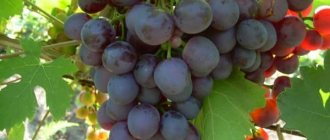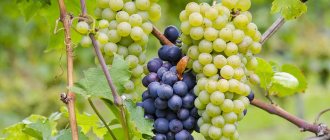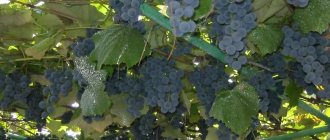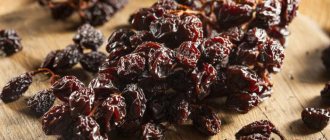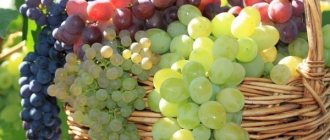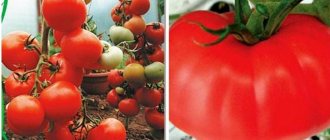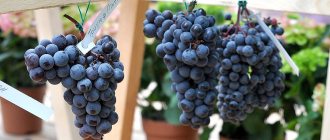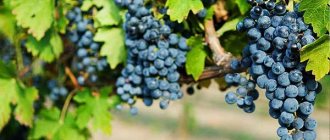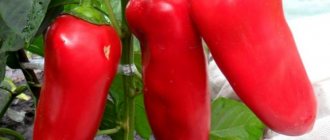Loading…
Loading…
Winegrowers who have experience selling their own harvest know that the first thing a buyer pays attention to is the appearance of the grapes. Beautiful bunches, consisting of many large berries, are sure to attract the buyer first, and the taste qualities are assessed a little later. A variety that claims to be called the best grape for the market must produce just such a harvest. The bushes must withstand stable and high yields, be subject to minimal risk of infection with diseases dangerous to the crop and loss of ovaries from pests. Thanks to constantly ongoing selection work, winegrowers are getting more and more interesting new varieties and forms, which, after testing, sometimes push aside the recognized leaders in the ranking of the best grape varieties.
Arcadia grapes: description and photo of the variety
Created by Ukrainian breeders from crossing Moldova and Cardinal, Arcadia is today recognized as one of the best grape varieties in many regions of the country where viticulture is developed.
The variety belongs to the table variety and produces a harvest 115–120 days after the start of the growing season. The plant forms a vigorous, early ripening vine with a powerful root system and good survival rate. Arcadia shows an average result in resistance to grape diseases; in order to protect the vine from mildew, two preventive treatments are needed; protection from powdery mildew is also required. The variety tolerates frosts down to –21 °C. When humidity changes, the berries sometimes crack, which affects the quality of the harvest.
As can be seen from the description and photo, Arcadia grapes form large, mostly dense clusters weighing from 0.5 to 2 kg. The shape of the brushes is cylindrical or close to conical. Weighing about 15 grams, the berries of this market variety can grow larger than 2.8 cm. Moreover, the berries are heart-shaped and have a beautiful yellowish or white color. Since the variety is very high-yielding, the fruits cannot accumulate a lot of sugars, but with low acidity, the taste of Arcadia will not disappoint. It is refreshing, pleasant and light, which is especially noticeable when eating fresh berries with a fleshy consistency.
Some of the best grape varieties in Russia
There are more than a thousand excellent early, middle and late grape varieties, the purposes of which are very diverse - some are good as dessert, others for wine and canning, some table and technical varieties are universal.
Video: the best grape varieties (with a brief description)
The best grape varieties for the Moscow region and St. Petersburg
Unstable temperatures, rainy summers in the Moscow region and possible prolonged return frosts - these factors are always taken into account when choosing a grape variety. Therefore, early varieties grow more often in garden plots near Moscow - the white-fruited Tason, Krasa Severa, Jubilee Novocherkassky, Rusven and the relatively early blue Athos.
In the damp temperate continental climate of St. Petersburg, the fruitful table hybrid Pamyatya Dombkovskaya with dark blue fruits, early ripening Laura with milky green large berries, Alyoshenkin, Harold, Livia, Druzhba are cultivated without fear.
Resistant to diseases and low temperatures, White Maxi is distinguished by large white-green berries with sourness and a fruity aroma. Of the technical varieties, gardeners near Moscow and St. Petersburg choose the uncompromising variety Lydia.
Video: the best grape varieties for the Moscow region and St. Petersburg
The best grape varieties for growing in Siberia and the Urals
Siberian gardeners practice growing frost-resistant early ripening grape varieties - Tason, Timur, white-fruited Tukai; Rochefort, Super extra, White miracle, Cardinal and Kodryanka with purple clusters, Delight, White giant are also popular. For winemaking, undoubtedly, Isobella and Lydia. The berries of Sharov’s selection never fail: Sharov’s Muscat and Sharov’s Riddle.
Photo gallery: grape varieties for growing in Siberia
The White Giant variety grows well in Novokuznetsk and Krasnoyarsk
Hybrid of Siberian selection Sharov's Mystery
Early maturing hybrid Muscat Sharova
Video: the best grape varieties for the Urals and Siberia
Grapes Kishmish radiant
The seedless berries of the mid-early grape Kishmish Radiant are well known to consumers. The variety, bred in Moldova from crossing the Cardinal and Kishmish pink grapes, ripens in 125–130 days and is distinguished by high yields that ripen on medium or vigorous bushes.
Kishmish Radiant is not highly frost-resistant and is susceptible to infections of this crop. At the same time, the variety is demanding of the grower’s attention, and with proper care it compensates for the efforts, producing large and medium-sized berries of golden and red-pink tones, up to 2.5 cm long and weighing up to 4 grams. I have ripe berries with a dense consistency and nutmeg taste and aroma. The clusters of one of the best grape varieties for the market reach 40 centimeters in length and can weigh more than 600 grams. The harvest is easily transported and stored for quite a long time.
Mid-season species
The variety of medium-sized grape varieties is simply amazing. Every year, breeders develop new forms with the best qualities and characteristics.
Kishmish radiata
A plant bred by Moldovan breeders. This variety was obtained by crossing two species - Cardinal and Kishmish Pink.
Fruiting occurs four months from the moment of swelling of the vegetative buds. The bushes are tall, the shoots are characterized by good development.
Kishmish Radiant - one of the best market varieties
Main characteristics:
- Large fruit.
- Large bunch size.
- Amazing taste of fruits with increased sugar content.
- High yield.
- Marketability of bunches.
- Seedless fruits.
This is the best sweet, mid-early grape variety. The harvest is consumed fresh and used to make high-quality wines, raisins and juices.
Antey Magarachsky
Table technical form with very tasty sweet fruits with a harmonious taste of chocolate. The brushes are small, cone-shaped, of moderate density. The berries are small, oval with a dark purple dense skin.
Valued for its high and stable yield. A crop that is weakly resistant to frost and disease. The best cultivation regions are the North Caucasus.
Varyushkin
A technical hybrid with simple-tasting but very sweet berries. The clusters are medium-sized, conical, and consist of rounded black berries. Each fruit contains fleshy and very juicy pulp with two seeds.
Varyushkin grapes are very sweet and juicy
This species is not characterized by high yield and is intended for cultivation in the North or the Caucasus.
Anapa stable
One of the best nutmeg hybrids of medium fruit ripening. The berries are amber in color with thick skin, collected in loose, conical clusters. Inside the fruits there is juicy pulp with a nutmeg flavor and 2-3 seeds.
Anapa resistant - a very undemanding variety
This culture belongs to the group of varieties that are weakly resistant to frost and disease. Productivity is high, but not stable.
Levokumsky
The best species for growing in the regions of the Middle Zone and the North. Its winter hardiness is thirty-five degrees below zero.
The Levokumsky variety produces grapes up to 1 kg
- This culture has other advantages:
- Disease resistance.
- High quality fruits.
- Good transportability and marketable appearance of the crop.
- Easy to care for.
- Increased sugar content of berries - up to twenty percent.
Krasnostop Zolotovsky
The technical form is of great value in winemaking for the production of high-quality red wines. Fruiting in the bushes occurs 4.5 months from the beginning of the growing season. Plants are characterized by moderate growth. The vines are ripening well. The berries are small, dark purple in color, collected in loose, medium-sized conical clusters. The fruit contains very juicy and sweet pulp.
Variety Krasnostop Zolotoskiy - an undeservedly forgotten, very sweet variety
This crop is not particularly winter-hardy or disease-resistant. The best growing region is the Krasnodar region.
Late species
This group is represented by unique species that not only have good frost resistance, but also excellent taste of the fruit.
Isabel
A unique table form of grape, bred by American selection. Grapes are widespread throughout all European countries and Russia.
This is a technical hybrid that is grown for the production of fine wines and delicious, aromatic juices.
Isabella variety - favorite autumn grape
Main characteristics:
- High presentability of the bunches.
- Excellent taste of fruits with a pronounced strawberry flavor.
- Tall bushes.
- Good ripening of vines.
- High immunity to diseases.
- Good yield.
This crop is intended for cultivation in temperate and warm climate zones. In the northern regions, the harvest does not have time to ripen before the first frost.
Moldova
The sweetest late-ripening grape hybrid. Characterized by strong growth, excellent ripening of branches and large fruits. The brushes are small, in the shape of a cylinder or cone with medium density. The berries are large, oval-shaped, dark purple in color with a dense waxy coating.
The Moldova variety has very tasty, dense, juicy berries
Belongs to high-yielding varieties with good winter hardiness and disease resistance. The fruits have good keeping quality, marketability and transportation.
Vostok-2
Large-fruited crop bred by Russian breeders. Forms large clusters with large fruits. The berries are spherical in shape, white in color with a pink tint. Inside the fruits there is dense, juicy and very sweet pulp. The fruits do not last long. Fruiting occurs at the end of October.
Vostok-2 grapes are not only tasty, but also very beautiful
Italy
An excellent muscat variety with large clusters and amber-colored berries. It was bred by Italian breeders as a result of crossing two species - Hamburg Muscat and Bican.
The bushes are characterized by strong growth. The maturity of shoots is satisfactory. The pulp is juicy, fleshy with a pleasant nutmeg aroma.
The yield of the variety is high, but not stable. This is a typical table variety, which is characterized by good preservation of berries, the ability to transport them over long distances and further long-term storage.
Description and photo of Codryanka grapes
According to the photo and description of the grapes, Codryanka can rightfully be considered one of the most interesting modern varieties. It takes from 110 to 118 days for Kordyanka berries, obtained from the parent varieties Marshallsky and Moldova, to ripen. The variety forms a vigorous, high-yielding vine that can support a mass of large clusters weighing from 400 to 1500 grams.
Among the disadvantages of the best grape varieties is the crushing of berries, which can be dealt with by using gibberellin, which will make the berries grow and reduce the number of seeds in them. Typically, grape fruits, about 3 cm long and weighing about 7 grams, are distinguished by their thick bluish-violet color, dense pulp and invisible skin. By the time the berries ripen, they accumulate quite a lot of sugar, but they acquire a pleasant taste even a little earlier. The brushes can be transported, are well stored and do not lose their quality for a long time if they remain on the bushes.
The best early grape varieties
Although the climatic conditions in the Moscow region are better than in the north, this area is still not particularly suitable for planting vineyards. This is due to the fact that June and half of July are usually hot here, and the second part of summer and early autumn are rainy. Because of this, the grapes crack and rot. To avoid this, it is better to plant early ripening varieties.
Anniversary of Novocherkassk
Rating: 5.0
The grape variety Jubilee of Novocherkassk occupies the first position in the ranking. It takes 110-120 days for the berries to ripen. The harvest is harvested at the end of summer. The bush grows strongly and is actively covered with large leaves. The weight of the bunches reaches 0.8-1.6 kg, and in rare cases up to 3 kg.
The berries are oval, oblong, yellow with pink. They look very attractive. Some bushes may have white berries with a pink tint or pure pink berries. The fleshy pulp is covered by a relatively dense skin. The taste of the grapes is harmoniously sweet, without any aftertaste. The riper the berry, the sweeter it is.
This grape variety has many positive reviews. Winegrowers note that it is resistant to frost (down to -23°C). He is not afraid of fungal diseases. Our experts included it in the rating because Novocherkassk Jubilee produces large, dense clusters. And strong grapes are perfectly transported and stored.
Advantages
- large bunches;
- sweetish harmonious taste;
- stable fruiting;
- berries are transported without problems;
- good disease resistance;
- frost resistance.
Flaws
- wasps love to attack this variety;
- requires normalization.
Tason
Rating: 4.9
The second place in the ranking was given to the Tason variety. It ripens in 100-110 days in the Moscow region, and in the south it is harvested already in mid-summer. The Tason grape bush is growing rapidly. It is covered with dark leaves that are formed from 5 lobes and have a strong dissection. The clusters are quite large (500-800 g), having a cylindrical-conical shape.
The grapes are oval, white-pink in color. Moreover, under direct rays of the sun, a tan appears on them, and in shaded places they remain without coloring. In the sun, the berries become translucent and have a beautiful amber hue. The bones are so small that you can hardly feel them. The skin is moderately dense and is practically not felt while eating. It covers the crispy, juicy flesh. The taste is dominated by sweetness, and the aroma has notes of nutmeg.
In reviews, winegrowers note that among early ripening varieties, Tason is the most delicious variety. This grape deserves to be among the best because it is resistant to gray rot, tolerates frosts down to -22 °C, always produces large fruits and is well transported. It appears on the market earlier than other varieties.
Advantages
- sweet taste, nutmeg notes in aroma;
- dynamic ripening;
- attractive-looking berries;
- transports well;
- can grow in any climatic conditions.
Flaws
- Frost resistance is not very high.
Muscat summer
Rating: 4.8
The Muscat summer grape variety, classified as a table grape, is in third position in the ranking. It takes 110-125 days to ripen. When it grows in the Moscow region, the fruits can be collected in early autumn. The bushes of this grape grow greatly. Some reach a height of up to 3 meters. All shoots bear fruit.
Bunches of summer Muscat grapes weigh from 500 g to 1 kg. Their shape is cylindrical with a loose arrangement of grapes. The berries are quite large and oblong. If the fruits ripen in the shade, they will be amber-white. And on the sunny side they acquire a bright amber color. The skin is quite dense, but it is quite possible to eat it. It covers the juicy and fleshy flesh.
Fans of this variety note in their reviews that the bushes feel good even at -23 °C, but they should still be covered for the winter. It is moderately resistant to diseases. The summer Muscat grape variety deservedly found itself in the ranking of the best, since it is unpretentious in care, perfectly decorates the yard and has high transportability.
Advantages
- special rich nutmeg taste;
- bisexual flowers;
- the vine ripens well;
- bears fruit effectively;
- transports well.
Flaws
- the skin on the berries is quite dense;
- affected by root phylloxera.
Super Extra
Rating: 4.7
The fourth place in the ranking is given to the amateur-selected grape variety Super Extra (second name Citrine). The crop is harvested in early August. Even a small number of warm months does not prevent this grape variety from bearing fruit well. Bushes of the Super Extra variety grow strongly. Each bunch weighs from 500 g to 1.5 kg.
The berries are white, egg-shaped, quite large (7-8 g). The peel is medium in density and thickness. Beneath it is juicy and fleshy pulp, which has a very harmonious taste. Super Extra is characterized by high productivity, but it has a tendency to peas, so special agrotechnical techniques should not be neglected.
In their reviews, winegrowers note that this variety has excellent taste characteristics and high yield. It is included in the ranking of the best because the strong skin of the berries facilitates the transportation of the harvest with virtually no loss. The variety is excellent for beginning winegrowers, as it takes root well and does not require special care. Super Extra can withstand frosts down to -23 °C.
Advantages
- the taste is pleasant, sweetish;
- high fruiting;
- does not lose its presentation during transportation;
- increased resistance to disease.
Flaws
- tendency to peas.
Beauty of the North
Rating: 4.6
The white grape variety Krasa Severa took fifth place in the ranking. The berries ripen in 110 days. They contain a lot of folic acid, so Krasa Severa is positioned as medicinal grapes. The bushes are growing strongly. The shoots ripen well. The clusters are quite large, cone-shaped and branched.
The berries are most often white, but they have a pinkish tint. They are usually large and oval in shape. The skin on one side is thin, but at the same time quite durable. It has a tart or herbaceous taste. It covers the fleshy, juicy flesh. The overall taste of the berry can be described as simple. A delicious juice is prepared from the Beauty of the North, which does not require added sugar.
Fans of this variety note in their reviews that Beauty of the North is consistently in demand on the market. Our experts included it in the rating of the best because it is easily transported and can not spoil for a long time after harvesting. The variety can withstand frosts down to -24-25 °C, and Krasa Severa also exhibits increased resistance to gray rot.
Advantages
- contains a lot of folic acid;
- at high humidity, the berries do not rot on the bush for a long time;
- high fruiting;
- good transportability.
Flaws
- under heavy rains the berries crackle.
Grape variety Hadji Murat
The basis for the work of Tajik scientists when breeding Hadji Murat grapes was the Zabalkansky and Hamburg Muscat varieties. As a result, the variety became one of the contenders for the title of the best grape variety for the market, and the berries on vigorous bushes ripen in 125–135 days.
Hadji Murat grapes survive frosts down to -22 °C, but feel better in a greenhouse or under winter shelter. Fruiting shoots of this variety ripen by 75% or more, supporting extremely large clusters weighing from 800 to 2500 grams and retaining their properties well during storage and transportation. The variety is high-yielding, tending to form a large amount of ovary, therefore, to ensure the quality of the berries, it is necessary to standardize the future harvest.
The clusters of Hadji Murat grapes have an even conical shape and medium density. Ripe oval berries can weigh from 15 to 25 grams, have a thick almost black color, are covered with a bluish waxy coating and have a decent taste.
Mid-season sweet grape varieties
Kishmish Radiant
The Kishmish Radiant grape is a seedless table variety of medium ripening. It has a sweet taste and is consumed fresh or dried. It is used to make delicious homemade wine with musky notes. It contains from 17 to 21 percent sugar, the berries are large, elongated, purple-pink in color.
The most favorable region for Kishmish Radiant is the south, the optimal temperature in winter is not lower than -15 degrees. In more severe climates, careful shelter is necessary, otherwise the grapes will die. The variety ripens in 130 days, the clusters are large, the skin is dense, which prevents wasps from feasting on the delicate pulp. It has an excellent presentation and good transportability.
Original
The Original grape has three varieties: white, black and pink. In terms of characteristics, they are almost identical, the only difference is the color of the skin. The purpose of this variety is table, consumed in fresh and processed form: compote, jam, preserves, marmalade. It ripens in 140 days, gaining sugar from 15% to 21%. Frost-resistant, tolerates down to -21 degrees in Ukraine and Russia. In some regions it grows only in greenhouse conditions under film.
The berries of the Original grape are cone-shaped, the skin is thin, almost imperceptible to the taste, the clusters are large. The pulp is sweet and watery, with a couple of small seeds inside. Due to its excellent presentation and taste, it is in demand among buyers.
Mascot
The Talisman grape is a popular mid-early sweet table variety that has rightfully won the love of gardeners. It grows well both in hot southern regions and in the northern ones, and can withstand frost of -25 degrees under cover. During the ripening period, it manages to accumulate a large amount of sugar (from 17 to 23%), which affects the taste characteristics.
The talisman is successfully used in grape breeding; the disadvantages include the fact that it requires pollination. With proper pollination, it produces an excessively high yield, so rationing of the bush is required.
The undeniable advantage is the large, slightly oval berries with a white-green thin shell and an amber barrel. The grape pulp is juicy, sweet, with an unobtrusive muscat flavor. The Talisman is consumed fresh and suitable for processing.
Concord
Another native of the USA is the Concord grape, which belongs to both a wine and a table variety. Ripening time is average, may vary depending on the place of growth: from 130 to 180 days. It grows well in the northern regions, central Russia and Ukraine, and in the south, without losing its yield and taste. Its berries are round, quite large, red-violet or dark blue.
Concord grapes are consumed fresh and processed into wine, juices, jams and marmalade. Sugar content is from 15 to 18%, the berries are sweet, juicy and aromatic. Grapes are transported well and can be stored for up to two months when cut. If you are late with pruning, the berries may crack on the bush. Does not like excess moisture, which also leads to cracking.
Marquette
Like the previous variety, Marquette grapes were bred in America through complex crossings of 8 progenitors to achieve ideal characteristics. This is a mid-season technical variety, which, if properly hardened, is not afraid of even 38 degree frosts, even without shelter. But since the buds wake up early, in the spring it is necessary to cover the bushes so that they do not die.
Its berries are round, small, with dark blue dense skin. Sugar content is high: from 24 to 30%, which allows you to make sweet and fortified wines from Marquette grapes with notes of chocolate, plum, cherry and blackberry. Due to its excessive sugar accumulation, it is often mixed with less sweet grapes. It is highly resistant to diseases and fungi.
Grapes Beauty
The beautiful dark pink berries with a deep purple tip of the Krasotka grape variety take from 110 to 110 days to ripen. Krasotka has bushes of medium vigor, well-ripening fruit-bearing shoots and smooth ones, weighing about 500–700 grams of the cluster. The variety demonstrates average resistance to common infections and pests.
The clusters contain elongated berries, about 3 cm long and weighing up to 6 grams, with a good fresh taste, juicy and quite fleshy pulp and a skin that is hardly noticeable when bitten. Krasotka grape berries can sometimes burst if there is an excess of moisture at the ripening stage. The fruits of this variety pick up sweetness well, but cannot compete in the brightness of taste with varieties for personal consumption.
Monarch grapes: photo and description of the variety
When choosing the best varieties for the market, Monarch grapes can receive the attention of gardeners and specialists, since at medium ripening periods they produce large, high-quality clusters weighing about 900 grams. The variety shows high productivity. One vine produces at least 7 kg of fresh berries of commercial quality.
According to the photo and description, Monarch grapes are distinguished by high growth vigor, good rooting of cuttings and ripening of more than 65% of the shoot length. The variety is frost-resistant and demonstrates high and medium resistance to known diseases of this crop. A characteristic feature of this grape is its large, 20-gram oval berries of a beautiful yellow color. The pulp has a juicy, but not liquid consistency and a wonderful, rich taste. After ripening, while on the vine, Monarch grape clusters, as in the photo and in the description, almost do not lose quality and can be stored and transported for a long time.
The best grape varieties in Bashkiria and Udmurtia
The famous hybrids Sharov, Pamyati Dombkovskaya and Korinka Russian were the first to be isolated for the risky farming zone in Bashkiria and Udmurtia. Super early and medium ripening varieties ripen fully and do not suffer from return frosts: Super Extra, Aladdin, Saratov's Gift, Baikonur, Libya, Monarch. Not uncommon - Kishmish radiata, Rumba and Violet early. The productive hybrids Kodryanka and Charlie are considered to be working varieties.
Photo gallery: some of the best varieties of Bashkiria and Udmurtia
Early Violet grapes give a good harvest in the climatic conditions of Bashkiria and Udmurtia
Early ripening variety Monarch
Pink hybrid Aladdin
To prevent the berries from splitting and falling off in the harsh Bashkir climate, it is recommended to treat the grapevine with various biostimulants (for example, Gibberellin)
Galahad grapes
The extremely early hybrid grape Galahad in the Kuban and other viticulture regions produces a harvest within 95–100 days after the start of the growing season. The plant received the title of the best grape variety for the market due to its highest taste, good vigor of bushes, the ability to winter at air temperatures down to –25 ° C, as well as noteworthy resistance to harmful fungi and rot.
The grapes produce beautiful, medium-density, conical clusters weighing up to 1.1 kg. The average length of the oval, large amber berries is 2.6 cm. The weight of the fleshy, sweet berry with a pleasant texture reaches 12 grams.
Photo and description of Super-extra grapes
The early maturity hybrid obtained by E. Pavlovsky produces a harvest 100–110 days after the appearance of the first leaves. By the end of July, on vigorous bushes of Super-Extra grapes, you can see large, up to 1.5 kg in weight, clusters of medium looseness. The variety is high-yielding, so the winegrower must regulate the ovaries and inflorescences.
According to the description and photo of the Super-Extra grapes, clusters consist of oval or ovoid large berries weighing 7–8 grams. The color of the berry is white or light amber. The berries gain sweetness very quickly, their pulp is pleasant, dense with a sufficient amount of juice.
The grapes resist diseases and winter frosts well. After picking, the bunches can be transported and stored; the only drawback is the variety of sizes of berries inside the bunch.
Varieties for winemaking
Technical grape varieties are used to produce wine. Their berries are not large in size or decorative in appearance, but contain a large amount of aromatic juice.
The weight of berries of technical grape varieties rarely exceeds 1.5 g.
Table: the most famous technical grape varieties
| Variety name | Peculiarities |
| Aligote | High-yielding variety of early-mid ripening period. Often suffers from fungal diseases and pests. The whitish-green berries have a characteristic flavor. Widely used for making dry wines. |
| Nominee | Winter-hardy variety of mid-late ripening. Its light green berries accumulate up to 25% sugars with an acidity of 5–5.6 g/l. Table and dessert wines made from them have a pleasant aroma and piquant taste. |
| Pomegranate | A mid-late, heat-loving variety that practically does not suffer from fungal diseases. The wine made from its blue-black berries has a bright red color and excellent taste. |
| Cabernet Sauvignon | A grape variety known throughout the world with a medium-late ripening period. Its small blue-black berries with a nightshade aroma form the basis of many fine wines. It has a relatively high resistance to frost (withstands temperatures down to -23°C) and fungal diseases. When a bush is overloaded with a crop, the sugar content in the fruit decreases, which is why the taste of the wine noticeably deteriorates. |
| Crystal | The yellowish-green berries of this variety ripen in the second half of August. They are used to make table and hybrid wines. A distinctive feature of Crystal is its high winter hardiness (up to -35°C) and immunity to most fungal diseases. |
| Muscat pink | Mid-early variety of Crimean selection. Pink berries weighing up to 1.8 g contain 22% sugar and 7–8% acids. The pulp has a strong nutmeg flavor. It is used to make dessert wines that consistently receive high marks from experts. |
| Magarach's firstborn | In the conditions of the south of Russia it ripens in late September. It is rarely affected by fungal diseases and can withstand frosts down to -25°C. Berries weighing up to 2 g, with durable white skin. The sugar content of the juice is 20–22% with an acidity of 6–8 g/l. |
| Riesling Azos | A modern hybrid of Rhine Riesling and Dzhemete varieties. Unlike its parent, it is resistant to grape aphids and fungal diseases. Azos Riesling berries are medium-sized, with thin white skin. The dry wine prepared from them is not inferior in taste to wine from Rhine Riesling (tasting score - 8.8 points). |
| Traminer pink | One of the oldest grape varieties of medium ripening. The berries, weighing no more than 1.5 g, contain a large amount of juice (about 80%) and sugars (22%), which makes it an excellent raw material for making dessert wines. The main disadvantage of the variety is low resistance to fungal diseases and frost. |
| White Feteasca (Leanka) | Mid-early white grapes with a high (up to 26%) sugar content in the berries. Often suffers from fungal diseases and spider mites. Relatively resistant to sub-zero temperatures. Widely used for making juice and wine. |
| Chardonnay | Relatively winter-hardy variety of medium ripening period. The berries are small (up to 1.5 g), with light green skin. Easily affected by fungal diseases. It is highly valued by winegrowers for its juicy, aromatic pulp, which produces high-quality wines. |
Grapes Furshetny
The Furshetny grape, which bears fruit 115–125 days after the start of the growing season, was bred in Ukraine by breeder V.V. Zagorulko from the Kuban variety and Gift to Zaporozhye. According to data obtained by winegrowers who have already become familiar with this grape, Furshetny has average resistance to fungal attack and successfully winters at a temperature of –22 °C. Powerful bushes of this species actively form shoots that almost completely ripen by autumn.
The brushes on the bushes are dense, closer to cylindrical in shape. The weight of a bunch, consisting of oval berries weighing up to 16 grams, is from 600 to 800 grams. The length of an individual berry is about 3.5 cm, the color is dark, reddish-violet with a pronounced waxy coating. One of the best grape varieties has a great taste with notes of raisins and ripe mulberries.
Acquaintance with the best varieties for the market does not end with the description of the Furshetny grape variety. Read the article about the best grape varieties for sale. We hope that our selection will help you make your choice and start growing grapes for sale.
What are the best table grape varieties?
Every winegrower or experienced grape lover probably has favorite table varieties.
Everyone has their own, so our list includes the most frequently mentioned ones and those with a special taste and characteristics. So, the best varieties of table grapes are:
- “talisman” is one of the most popular species, with high yield, large fruits and harmonious taste;
- "arcadia", with its elongated golden berries;
- “rizamat” - as already mentioned, a generally recognized standard of taste, ripens early and has large berries;
- “Kishmish Moldavian” is an unpretentious grape with a large bunch and fruits without seeds;
- “Cardinal” is a stable, quickly ripening variety with an interesting taste.
What are the benefits of grapes for women? Varieties of black grapes and their characteristics.
